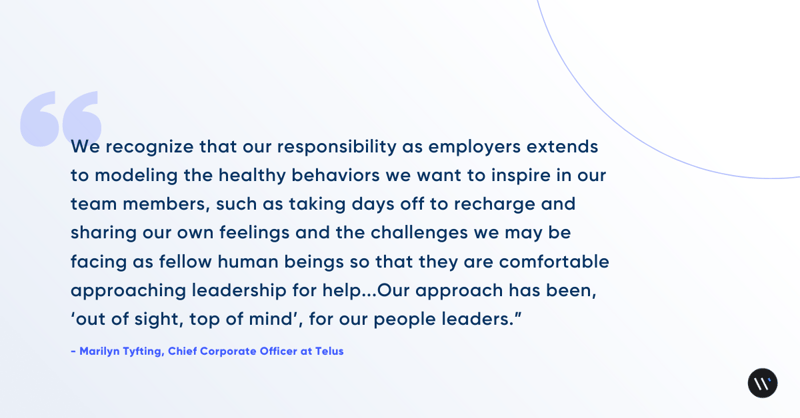As a business leader, it is very important to address the stigmas surrounding mental health in order to create a positive work environment. Whether it’s seeing our loved ones battle with their mental health, or addressing our own internal struggles, these challenges are something that we all deal with in some way, shape, or form.
Poor mental health can have a detrimental effect on employee wellness, job performance, productivity, and communication if left unaddressed — and unfortunately, the impact of mental health on newly remote workers has only grown since the beginning of the COVID-19 pandemic:
-
After one month of quarantine, 75% of people say they feel more socially isolated, and 53% say that they feel more emotionally exhausted after the sudden shift towards work from home.
-
Rates of depression and anxiety in June 2020 were three to four times higher compared to the reported numbers from June 2019.
-
Studies have identified a number of negative psychological effects caused by long term isolation, including post-traumatic stress symptoms, confusion, and anger.

The good news is that employers can help their employees with addressing and improving their mental health. Just like our physical health, this is an area that we have to train and continue to work on over time. Our bodies and physical health are constantly changing and evolving, with new areas to address as we progress through life. Our mental health is no different. So why do we approach the subject so differently?
Although there has been more much-needed discussion around the subject in recent years, there is still a stigma surrounding the idea of mental health that is present in society. A study from the American Psychiatric Association shows that 1 of every 3 workers are concerned about negative backlash and potential job loss if they were to seek out mental health assistance.
These concerns are rooted in a number of negative connotations and beliefs that affect our society’s perception of those with mental health issues. There are three primary misconceptions, as identified by the World Psychiatry Journal, that the general public seems to gravitate towards:
-
People with severe mental illnesses should be feared and excluded
-
People with severe mental illnesses are irresponsible or unable to make their own decisions
-
People with severe mental illnesses are childlike and need to be cared for
This public stigma of fear, judgement, and pity can often be internalized, further contributing to the reluctance to seek treatment or reach out for help.
Addressing Mental Health Challenges Remotely
Developing a positive and welcoming company culture is vital to the overall success of a business. Not only have happier workers been proven to work harder and more productively, but retention rates are higher for organizations that enforce mental health practices within the workplace. So, from a management perspective, how can employers do their part to address mental health within the workplace?
Be A Source Of Emotional Support
With social distancing restrictions still in place, many employees have been working remotely for the past few months, unable to interact in person. The effects of social isolation can have a negative effect on your employees’ mental health, and an inability to connect with others within a remote work environment can even lead to a departure from the company.
Employers can take steps towards offering encouragement and emotional support for their remote employees by periodically checking in via phone or video call. Give your team the space to voice their concerns, whether personal or work-related, and take the time to actively listen. This can be done in a team setting, with interactive icebreakers that give everyone the chance to take the floor, as well as in a 1:1 setting for more private discussions. Your employees should feel confident knowing that they can look to the leadership team for guidance and support whenever they need it.
Facilitate Open Dialogue Surrounding Mental Health
We’ve mentioned how stigmas and misconceptions have made it difficult to have discussions about mental health awareness. As an employer, it helps to approach the subject of mental health head-on and show your team that you have their best interests in mind.
This can be as simple as addressing the impact of current events and social issues on employee wellness. Many leadership teams tend to avoid bringing up sensitive topics in fear of increasing stress. However, a recent report from the Harvard Business Review states that “those still relying on a strategy of abstention and neutrality are quickly learning that it no longer works the way it once did...sometimes it leads to more harm than good.”
Provide Resources And Information
Some of your employees may not be ready to vocalize their challenges with mental health just yet. However, you can still point them in the right direction by providing access to mental health services and resources available virtually.
Consider compiling a list of articles, books, virtual therapists, online forums, and more to distribute to your team of remote workers. Add to this list over time and encourage your employees to submit additional resources as well. If your organization’s health insurance options include any mental health benefits, be sure to bring this to your team’s attention as well — while Employee Assistance Programs are offered by more than 90% of organizations, many are underutilized due to a lack of awareness from employees. Making mental health resources accessible and attainable is a huge part of breaking down the stigma and promoting overall wellness.
Implement Mindfulness and Wellness Programs
Developing a workplace wellness program is a reliable way to facilitate health and happiness within your organization. Similar to physical-related based challenges such as monthly step counting contests, wellness challenges that focus on mental health can allow your team to incorporate yoga, meditation, and other mindful practices into their daily routine. The goal of mindfulness-centric practices is to reduce stress by focusing on and appreciating the present, and many business executives have adopted these programs and exercises into their day to day routines.
More than 20% of companies —- including Apple, Nike, and Procter and Gamble —- have begun incorporating wellness and mindfulness programs in order to keep their team engaged and motivated. Wellness Coach is a great tool for building an internal wellness program that’s right for your organization. The Premium package allows you to coordinate virtual private team sessions hosted by expert wellness coaches. From stress management to fitness and yoga, your team will be able to virtually practice mindfulness and wellness as a group, creating that sense of community to combat any feelings of stress and isolation. Progress badges and usage reports will help you track individual progress as well. It’s a great way to add incentive and an element of friendly competition while encouraging your team to prioritize their mental health by building daily wellness habits.
Invest In Your Employees’ Mental Health
Overall, it is important for business leaders to understand the benefits of making your team’s health and happiness a priority. More than 80% of employees clinically diagnosed with mental health issues have kept it a secret from their employer; being proactive about addressing this subject will help more people than you might think. Not only will you build a sense of trust and empathy within your organization, but you will see the effects of mental health improvements on your employees’ productivity and output as well.
Remember: there are resources available to help you introduce positive habits without investing thousands of dollars building a wellness initiative from scratch! Try one free month of Wellness Coach for Enterprise for a firsthand look at the benefits of wellness in the workplace.
.png)

.svg) Share
Share.svg) Tweet
Tweet.svg) Post
Post.svg) Mail
Mail